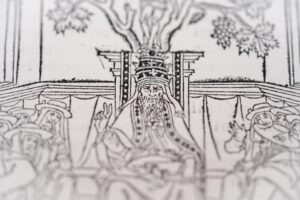I first heard of the name Lemuria from Ray Harryhausen’s film, The Golden Voyage of Sinbad. As a child, I was equally entertained by the cheesiness of 1970s filmmaking as well as the idea of lost ancient lands. The main characters’ goal in the film was Lemuria, an island that contained the answers to all secret knowledge.
Beyond the film, some believe in the fantastical claim that Lemuria was not just an island but an entire continent. Supposedly, this mysterious continent is where humanity originated.
Theory gone awry
Thousands of years ago, so the story goes, Lemuria sunk beneath the waves of the Indian Ocean after a great cataclysm. Does this sound familiar? Yes, it is one of the many mythical lost continent legends reminiscent of Atlantis. However, the theory of its existence does not trace back to some ancient Greek philosopher, as Atlantis does. The notion of Lemuria is fairly recent. A British zoologist named Philip Sclater came up with it in 1864.

Lemurs, where the name Lemuria comes from. Photo: Martin Mecnarowski/Shutterstock
He found lemur fossils in India and Madagascar rather than in Africa. To explain this, he suggested that India and Africa were once part of a larger continent in the Indian Ocean thousands of years ago. He called it Lemuria, after the animals he’d been studying.
Not long after, in 1868, German biologist Ernst Haeckel hopped on this claim and posited that Lemuria was humanity’s birthplace, not Africa, as Darwin claimed.
What started as a harmless explanation for these “anomalies of the mammal fauna of Madagascar” morphed into something hijacked by esoteric beliefs. Lemurs no longer have anything to do with it.
Land of Mu
The name Lemuria was shortened and took on the mythical persona of a land called Mu. This was popularized in the work of pseudoarchaeologist Augustus Le Plongeon. He was the one primarily responsible for turning Lemuria into something otherworldly.
Le Plongeon came upon the name while studying and translating the Mesoamerican mythological text Popol Vuh. The name Mu is most likely a mistranslation, but it stuck.
Occult writer James Churchward built on Le Plongeon’s hypothesis. According to him, all of the world’s ancient civilizations, including the Egyptians, Inca, Indians, Babylonians, and Persians came from Mu. Somehow, Mu survived calamitous volcanic eruptions, earthquakes, and fires. Churchward elaborates further, saying that the land mainly consisted of granite, which resisted these forces.

James Churchward’s map of Mu. Photo: James Churchward
He supposedly attained this information from priests in a temple while visiting India. They showed him ancient tablets written by an ancient race called the Naacal, the people of Mu. Mu, he said, once had 64 million citizens. In his book The Lost Continent of Mu, Churchward locates Mu “somewhere north of Hawaii to the south as far as the Fijis and Easter Island, and undoubtedly the original habitat of men.” In a certain way, you have to admire his presumptuous “undoubtedly.”
Simple plate tectonics
Despite all these claims, the plate tectonic theory wins every time. A continent can’t just sink into the ocean. There are multiple layers of rock, kilometers thick.
In one sense, Sclater was not that far off. India and Madagascar did break off from a bigger continent, although not Lemuria. Rather, the two countries came from a Precambrian-era micro-continent called Mauritia. It broke up around 84 million years ago. But this is simple continental shifting, not an overnight cataclysm.
There is no evidence on the sea floor to suggest a sunken continent.
Lemuria as a political and religious tool
Churchward and others also tied Lemuria to the Bible, citing it as the Garden of Eden or the Naccal’s role in birthing great biblical figures like Moses.
We’ve mentioned Theosophy founder Helena Blavatsky in a previous article. She claimed that Lemurians were the third root race of early humans. Other root races included Atlanteans from Atlantis and Aryans.
The esoteric perceptions of Lemuria did not die with plate tectonics. Rather, there is a place called Lemuria in California, founded by a religious group in 1936. It seems to fully embrace the supposed teachings of the civilization of Mu, including many ideas put forward by Blavatsky, such as human spiritual evolution and karma.

Nan Madol in Micronesia. Photo: Shutterstock
Some have tried using Lemuria as a political tool. For example, the nationalist Tamil government sought to capitalize on legend and equate Lemuria with a kingdom called Kumari Kandam, which it deemed the cradle of civilization. Ataturk, the controversial founder of modern Turkey, said Lemuria was the ancestral birthplace of the Turks.
Archaeological ‘evidence’
Pseudoarchaeologists suggest that remnants of the Lemuria/Mu are somewhere in the Pacific. Churchward and popular TV shows highlighted a site called Nan Madol in Micronesia. Much of it is partially submerged and has a layout similar to Venice in Italy. Due to some confusion and ambiguity about its age and purpose, some enthusiastic researchers suggest that it is part of a lost civilization. Other proposed sites for Lemuria include the Yonaguni Monument in Japan and Easter Island.
Conclusion
It is astounding that Lemuria began as a way to explain how lemurs got to Madagascar. Sclater did not intend for his idea to evolve into another lost continent legend. In this case, Lemuria morphed from a reasonable scientific theory to a spiritual belief system.
The common theme here is humanity’s natural inclination to figure out where we came from. We strive to understand our past, present, and future as a species. In this quest, fringe stories of lost continents are nothing new.






